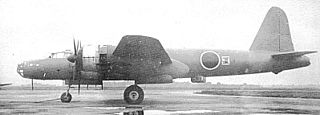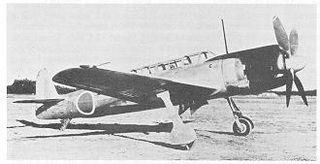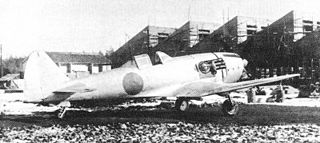
The Kyūshū J7W Shinden is a World War II Japanese propeller-driven prototype fighter plane with wings at the rear of the fuselage, a nose-mounted canard, and a pusher engine.

The Aichi B7A Ryusei was a large and powerful carrier-borne torpedo-dive bomber produced by Aichi Kokuki for the Imperial Japanese Navy Air Service during the Second World War. Built in only small numbers and deprived of the aircraft carriers it was intended to operate from, the type had little chance to distinguish itself in combat before the war ended in August 1945.

The Kawanishi N1K is an Imperial Japanese Navy fighter aircraft, developed in two forms: the N1K Kyōfū, a floatplane designed to support forward offensive operations where no airstrips were available, and the N1K-J Shiden, a land-based version of the N1K. The N1K-J was considered by both its pilots and opponents to be one of the finest land-based fighters flown by the Japanese during World War II.

The Mitsubishi A7MReppū was designed as the successor to the Imperial Japanese Navy's A6M Zero, with development beginning in 1942. Performance objectives were to achieve superior speed, climb, diving, and armament over the Zero, as well as better maneuverability – all parameters that were ultimately achieved towards the end of its development in 1945. However, limitations on Japanese industry towards the end of the war prevented the A7M from ever entering mass production or being deployed for active duty, and it never saw active service. Its Allied reporting name was "Sam".

The Nakajima Ki-44 Shoki was a single-seat fighter-interceptor which was developed by the Nakajima Aircraft Company and operated by the Imperial Japanese Army from 1942 to 1945 during World War II. Its official designation was Army Type 2 Single-Seat Fighter (二式単座戦闘機) and its Allied reporting name was Tojo.

The Mitsubishi J2M Raiden is a single-engined land-based fighter aircraft used by the Imperial Japanese Navy Air Service in World War II. The Allied reporting name was "Jack".

The Nakajima G8N Renzan was a four-engined long-range bomber designed for use by the Imperial Japanese Navy. The Navy designation was "Type 18 land-based attack aircraft" (十八試陸上攻撃機); the Allied code name was "Rita".

The Nakajima Ki-84 Hayate is a single-seat fighter flown by the Imperial Japanese Army Air Service in the last two years of World War II. The Allied reporting name was "Frank"; the Japanese Army designation was Army Type 4 Fighter. The Ki-84 is generally considered the best Japanese fighter to operate in large numbers during the conflict. The aircraft boasted high speed and excellent maneuverability with an armament that gave it formidable firepower. The Ki-84's performance matched that of any single-engine Allied fighter it faced, and its operational ceiling enabled it to intercept high-flying B-29 Superfortress bombers. Pilots and crews in the field learned to take care with the plane's high-maintenance Nakajima Homare engine and landing gear prone to buckling. The difficulties of Japan's situation late in the war took a toll on the aircraft's field performance as manufacturing defects multiplied, good quality fuel proved difficult to procure, and experienced pilots grew scarce. Nevertheless, a well-maintained Ki-84 was Japan's fastest fighter. A total of 3,514 aircraft were built.

The Nakajima J1N1 Gekkō is a twin-engine aircraft used by the Imperial Japanese Navy during World War II. A prototype first flew in May 1941. The first full production variant of the Gekkō, the J1N1-C was a reconnaissance aircraft, although many of these underwent field modification into night fighters; in addition, a night fighter variant, the J1N1-S was later put into production. Towards the end of the war, J1N1 pilots also undertook kamikaze anti-shipping missions. The Gekkō was given the Allied reporting name "Irving".

The Yokosuka P1Y Ginga is a twin-engine, land-based bomber developed for the Japanese Imperial Navy in World War II. It was the successor to the Mitsubishi G4M and given the Allied reporting name "Frances".

The Nakajima C6NSaiun is a carrier-based reconnaissance aircraft used by the Imperial Japanese Navy Air Service in World War II. Advanced for its time, it was the fastest carrier-based aircraft put into service by Japan during the war. The Allied reporting name was Myrt.

The Kawasaki Ki-45 Toryu is a two-seat, twin-engine heavy fighter used by the Imperial Japanese Army in World War II. The army gave it the designation "Type 2 Two-Seat Fighter"; the Allied reporting name was "Nick". Originally serving as a long-range escort-fighter, the design — as with most heavy fighters of the period — fell prey to smaller, lighter, more agile single-engine fighters. As such, the Ki-45 instead served as a day and nighttime interceptor and strike fighter.

The Kawasaki Ki-60 was an experimental Japanese pre-World War II fighter aircraft that used a license-built (Kawasaki) DB 601 liquid-cooled engine. This was at that time an unusual choice because the majority of Japanese aircraft at that time used air-cooled radial engines.

The Tachikawa Ki-94 was a single-seat fighter-interceptor aircraft project undertaken by the Tachikawa Aircraft Company and to be operated by the Imperial Japanese Army. The project refers to two aircraft designs: the Ki-94-I and the Ki-94-II, both of which did not advance beyond the mock-up and prototype stage respectively.

The Kawasaki Ki-96 was a Japanese single seat, twin-engine heavy fighter of World War II. It was intended to replace the Kawasaki Ki-45s of the Imperial Japanese Army Air Service. However, it was not adopted and only three prototypes were built.

The Nakajima Ki-87 was a Japanese prototype high-altitude fighter-interceptor of World War II. It was a single seat, exhaust-driven turbo-supercharged engined, low-wing monoplane with a conventional undercarriage.

The Mitsubishi Ki-83 (キ83) was a Japanese experimental long range heavy fighter designed near the end of World War II. It did not reach production status.

The Aichi S1A Denko was a Japanese night fighter, intended to replace the Nakajima J1N1-S Gekkou. Like the Gekkou, it was to be equipped with radar to counter the B-29 air raids over Japan. Development time for the S1A increased while trying to overcome design shortcomings, such as the insufficient power of the Navy's requested Nakajima Homare engines, resulting in no aircraft being completed before the war ended.
The Mitsubishi J4M Senden or Navy Experimental 17-Shi Otsu B Type Interceptor Fighter Senden, Allied reporting name Luke, was a Japanese World War II fighter aircraft proposed by Mitsubishi Heavy Industries for use by the Imperial Japanese Navy. The J4M project did not proceed beyond the design stage.
The Nakajima D3N was a Japanese carrier-based dive bomber of the 1930s. Three prototypes were built for the Imperial Japanese Navy, but no production followed, with the Aichi D3A being selected instead.


















